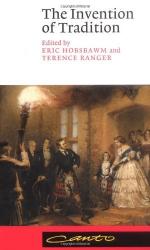
|
| Name: _________________________ | Period: ___________________ |
This test consists of 15 multiple choice questions and 5 short answer questions.
Multiple Choice Questions
1. Europeans responded to the changes by ______ some of the practices and leaving others alone.
(a) Abstracting.
(b) Eliminating.
(c) Ossifying.
(d) Expanding.
2. The author derides the British media for thinking the rituals are over ______ years old when in fact they are relatively new.
(a) 50.
(b) 1000.
(c) 500.
(d) 100.
3. According to the book, _______ had the biggest media impact on the broadcast of figures of the monarchy including George V.
(a) The BBC.
(b) The AAC.
(c) The ABC.
(d) The PBS.
4. According to the book, even ______ resistance movement could not initially dislodge the British.
(a) Ghandi's.
(b) The Pope's.
(c) Mandela's.
(d) Mother Teresa's.
5. According to the book, the fourth period is characterized by romantic glamor, partly due to ________ advances.
(a) Technological.
(b) Ethical.
(c) Religious.
(d) Moral.
6. At the end of the third period, Cannadine suggests there was a high level of _______ exploitation and commemoration.
(a) Religious.
(b) Racist.
(c) Commercial.
(d) Political.
7. At the beginning of Chapter Four, the author notes that few heads of state are more popular than _______.
(a) Queen Elizabeth II.
(b) King Louis XV.
(c) King Edward V.
(d) Queen Elizabeth I.
8. During the third period, ceremonies became symbols of national hope and pride. Large ______ ceremonies for royal children helped to convey this aspect.
(a) Marriage.
(b) Baptism.
(c) Golden jubilee.
(d) Rites of passage.
9. During the ceremony, the British authority in India was said to have been created by ________ to do what native authorities could not.
(a) The queen.
(b) Providence.
(c) The emperor.
(d) The king.
10. According to the book, African ______ and intellectuals used neo-traditions to enhance their own power.
(a) Diplomats.
(b) Peasants.
(c) Proletariat.
(d) Chiefs.
11. According to the author, the British ruled through the ______ emperor, but due to differences in culture, British prestige was difficult to maintain.
(a) Afghan.
(b) Punjab.
(c) Delhi.
(d) Mughal.
12. Love of ______ and economy brought hatred of displays of wealth by the crown, who also endured indifference from the clergy.
(a) Money.
(b) Tradition.
(c) Poverty.
(d) Freedom.
13. The official sanction of the Empress of India was established by the _______ of 1876.
(a) Royal Stewardship Act.
(b) Royal Titles Act.
(c) Royal Entitlement Act.
(d) Royal Names Act.
14. Blacks were intentionally _______ by the creation of specialized social categories based on European models.
(a) Unified.
(b) Militant.
(c) Divided.
(d) Co-mingled.
15. One process the Europeans used was to spread the norms of _______ and attach them to various occupations.
(a) Hostility.
(b) Tradecraft.
(c) Aggression.
(d) Gentility.
Short Answer Questions
1. The book states that blacks were taught ______ through monarchical traditions.
2. According to the book, the committee also intended to impose a British ideal of aristocracy and _______ on the people.
3. For the assemblage, a/an _______ was built and the seating of Indian rulers was arranged.
4. Unlike India, Africa did not have an organized form of state rule and thus the Europeans had to use _______ ideology.
5. The author states that the last great ceremony in the third period was _________ coronation in 1953.
|
This section contains 457 words (approx. 2 pages at 300 words per page) |

|




